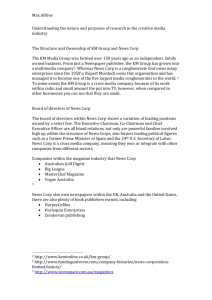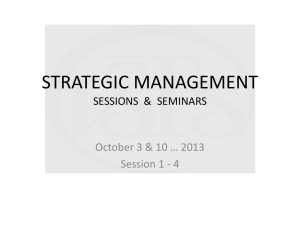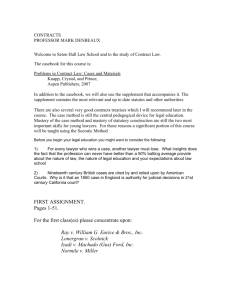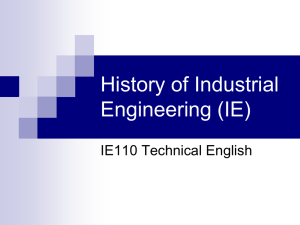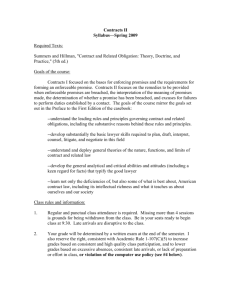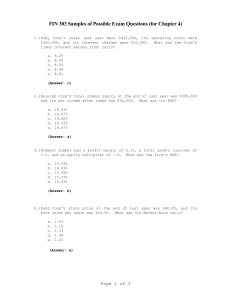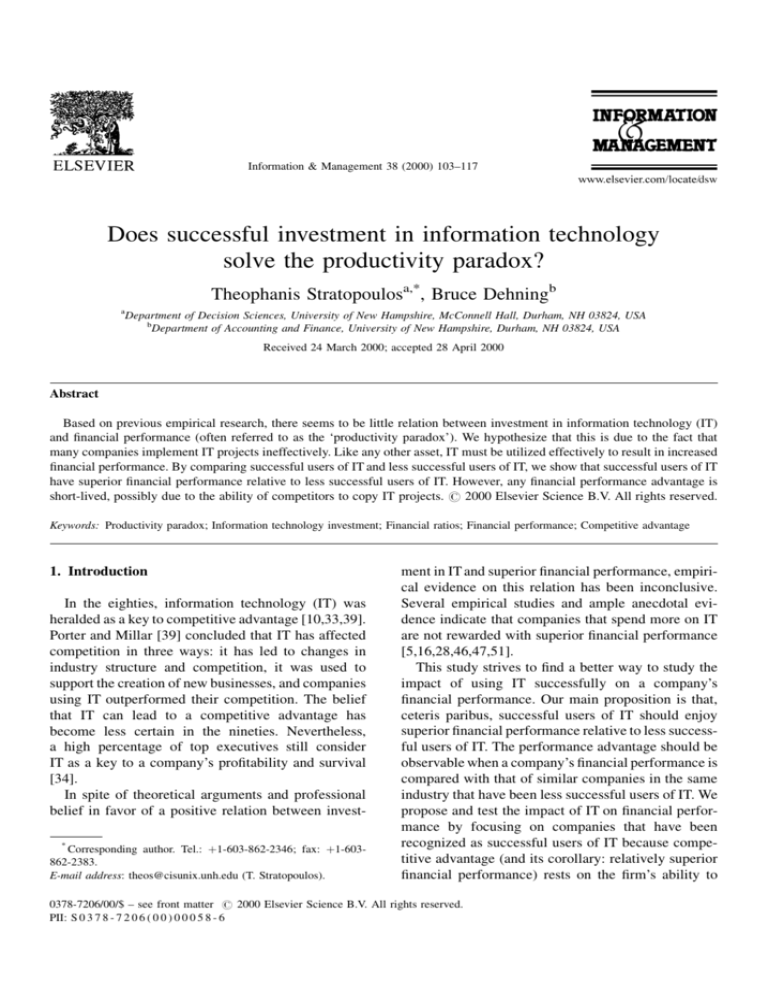
Information & Management 38 (2000) 103±117
Does successful investment in information technology
solve the productivity paradox?
Theophanis Stratopoulosa,*, Bruce Dehningb
a
Department of Decision Sciences, University of New Hampshire, McConnell Hall, Durham, NH 03824, USA
b
Department of Accounting and Finance, University of New Hampshire, Durham, NH 03824, USA
Received 24 March 2000; accepted 28 April 2000
Abstract
Based on previous empirical research, there seems to be little relation between investment in information technology (IT)
and ®nancial performance (often referred to as the `productivity paradox'). We hypothesize that this is due to the fact that
many companies implement IT projects ineffectively. Like any other asset, IT must be utilized effectively to result in increased
®nancial performance. By comparing successful users of IT and less successful users of IT, we show that successful users of IT
have superior ®nancial performance relative to less successful users of IT. However, any ®nancial performance advantage is
short-lived, possibly due to the ability of competitors to copy IT projects. # 2000 Elsevier Science B.V. All rights reserved.
Keywords: Productivity paradox; Information technology investment; Financial ratios; Financial performance; Competitive advantage
1. Introduction
In the eighties, information technology (IT) was
heralded as a key to competitive advantage [10,33,39].
Porter and Millar [39] concluded that IT has affected
competition in three ways: it has led to changes in
industry structure and competition, it was used to
support the creation of new businesses, and companies
using IT outperformed their competition. The belief
that IT can lead to a competitive advantage has
become less certain in the nineties. Nevertheless,
a high percentage of top executives still consider
IT as a key to a company's pro®tability and survival
[34].
In spite of theoretical arguments and professional
belief in favor of a positive relation between invest*
Corresponding author. Tel.: 1-603-862-2346; fax: 1-603862-2383.
E-mail address: theos@cisunix.unh.edu (T. Stratopoulos).
ment in IT and superior ®nancial performance, empirical evidence on this relation has been inconclusive.
Several empirical studies and ample anecdotal evidence indicate that companies that spend more on IT
are not rewarded with superior ®nancial performance
[5,16,28,46,47,51].
This study strives to ®nd a better way to study the
impact of using IT successfully on a company's
®nancial performance. Our main proposition is that,
ceteris paribus, successful users of IT should enjoy
superior ®nancial performance relative to less successful users of IT. The performance advantage should be
observable when a company's ®nancial performance is
compared with that of similar companies in the same
industry that have been less successful users of IT. We
propose and test the impact of IT on ®nancial performance by focusing on companies that have been
recognized as successful users of IT because competitive advantage (and its corollary: relatively superior
®nancial performance) rests on the ®rm's ability to
0378-7206/00/$ ± see front matter # 2000 Elsevier Science B.V. All rights reserved.
PII: S 0 3 7 8 - 7 2 0 6 ( 0 0 ) 0 0 0 5 8 - 6
104
T. Stratopoulos, B. Dehning / Information & Management 38 (2000) 103±117
manage IT related inputs in a more productive way
[38].
Using non-parametric statistics, we test to see if
there is any difference in the ®nancial performance
of successful users of IT and a carefully matched
control group. The successful users of IT were
chosen by independent experts in the ®eld of IT,
and the control group was matched on SIC code,
sales and total assets. Performance was assessed
using various measures of pro®tability and ef®ciency
over a period of 10 years. Statistical analysis
indicates that companies that have been identi®ed
as successful users of IT outperform their competitors
in measures of pro®tability and ef®ciency. However,
any ®nancial performance advantage is short-lived,
possibly due to the ability of competitors to copy
IT projects.
2. Literature review
The seemingly obvious yet elusive relation between
investment in IT and productivity, dubbed the `productivity paradox', has been the center of numerous
news articles, editorials, research projects and books
[1,6±8,17,22,28,30,31,40,45±47,51]. Although the
spectrum of these studies ranges from the role of
investment in IT on the economy, industry, and at
the ®rm-speci®c level, the latter is related to this study.
For a detailed review of the literature on the productivity paradox, see [6±8,22].
In a series of articles and two books, Strassman
[46,47] presents the results of his ®ndings and the
®ndings of several other studies. The conclusion he
draws is that there is no identi®able association
between expenditures on IT and pro®tability, and this
relation has not changed for more than 20 years.
In his 1990 book, he presents the results of an
analysis based on 292 companies. The scatter plot
used to relate investment in IT and return on investment (ROI) reveals a random pattern. When he replicated his analysis using 1994 data for a group of 539
companies, the results were equally disappointing.
The results do not change when he experiments with
several different measures of pro®tability such as
return on assets (ROA), return on net investment,
and economic value added over equity. Segmenting
his data set at the industry level did not improve the
results. Strassman concludes that it is not how much
you spend on IT, but how you manage your IT assets
that makes the difference.
Weill [51] used data from the valve manufacturing
industry to test the relation between investment in IT
and ®rm performance, sales growth, ROA, and two
measures of productivity. To better understand the
impact of IT on performance, Weill categorized IT
investment as strategic or transactional, depending
upon the management's intention. Although transactional IT investment was found to be signi®cantly
associated with ®rms experiencing strong performance, strategic IT investment was found to be neutral
in the long term, and associated with poorly performing companies in the short term.
Yosri [52] studied the relation between IT expenditures (operational, strategic and tactical), and revenue-contributing factors in 31 major food ®rms for
the period of 1987±1990. Yosri found no signi®cant
correlation between IT investment and sales growth,
market share gain, new market penetration, measures
of quality improvement, and productivity.
Dos Santos et al. [16] ®nd that an announcement of
innovative IT has a positive effect on stock price. The
announcement of non-innovative IT has a negative
impact on stock price. Overall, announcements of
investment in IT have no impact on stock price.
Loveman [30] used a microeconomic production
function to estimate the impact of IT on productivity.
Using sales minus change in inventory as a surrogate
for output, and various non-IT expenditures, labor
compensation, and IT capital as inputs, Loveman
found that the output elasticity of IT was negative.
This was interpreted as a suggestion to businesses that
they are better off investing their marginal dollar in
non-IT factors of production.
Barua et al. [5] used a process-oriented methodology to measure the impact of IT on strategic business
units. Their main proposition is that the impact of
investment in IT will be captured at low organizational
levels by intermediate level variables (ex: inventory
turnover). These variables in turn will impact output
measures. Using data from the manufacturing sector
for a period of 5 years, they found that IT indeed had a
mostly favorable impact on intermediate variables.
Intermediate variables were found to be signi®cant
determinants of high-level economic variables such as
ROA and market share.
T. Stratopoulos, B. Dehning / Information & Management 38 (2000) 103±117
Hitt and Brynjolfsson [22] used a panel of 370
companies over the period 1988±1992, and tried to
replicate previous studies to the degree that it was
feasible. They examined the impact of IT spending on
ROA, return on equity (ROE), and total shareholder
return. Even after they introduced controls (®rm-speci®c variables affecting pro®tability) to control for the
possibility of spurious correlation, the results indicated no correlation between spending on IT, total
shareholder return, ROA or ROE.
Mahmood et al. [31] used a 3-year, cross-sectional
analysis (companies from Computerworld's Premier
100 (CWP100) list for the years 1991±1993) to compare the impact of IT investment from previous years
with organizational performance and productivity of
the following years. They used cluster analysis to
classify ®rms based on their IT investments, performance and productivity. Their results suggest `to some
degree', a relation between investment in IT, performance and productivity. For the three sub-periods in
their sample, they ®nd a positive relation between IT
investment and change in revenue growth. Results for
the relation between IT investment and other measures
of productivity and performance were not as clear.
3. Methodology
Investment in IT has been on an upward trend for
the last 30 years. This upward trend can be seen in both
relative and absolute terms; the former through the
National Income and Product Accounts (NIPA) [49],
and the latter from several extensive surveys by IT
consulting ®rms.
Computers appear as a subcategory of the major
components of the NIPA. More speci®cally, computer
spending by companies is captured under the heading
`Producers Durable Equipment', which is a subcategory of `Business Fixed Investment'. According to
Haimowitz [21], real computer spending as a share of
business ®xed investment has risen from 2.12% in
1982±1986, to 13.11% in 1992±1996. Over the same
two periods, the share of computer spending in terms
of producers' durable goods has risen from 3.53 to
17.88%. The above percentages may underestimate
the actual share, if you consider the fact that the
de®nition of computers in the NIPA includes hardware
but not software, unless the latter comes preloaded on
105
the computer. According to Bakos [2], recent estimates raise the investment in IT to 30% of new capital
investment.
According to a 1995 report of the Standish Group
[43], ``In the United States we spend more than $250
billion each year on IT application development.''
Strassmann [48] reports this ®gure to be $700 billion.
Cap Gemini's 1998 Millennium Index study raised the
year 2000 spending for Europe and the US to $850
billion [9]. Several studies have attempted to estimate
the worldwide spending on IT. A 1998 study by the
market research ®rm Killen & Associates [26] estimated worldwide spending on IT to be $1.59 trillion
and projected this to be $2.62 trillion in 2002. Computer Economics [11] in their `1999 Information
Systems and eBusiness Spending' report estimate
the worldwide spending on IT for 2001 to be $1.1
trillion. All sources, drawing evidence from interviews
and survey responses from company executives worldwide, agree that spending is not expected to slow down
in the near future.
One would expect this investment to translate into
improved ®nancial performance; otherwise, the
investment would seem irrational. As we have already
seen, most of the empirical studies have concluded
that either there is no relation between investment in
IT and enhanced ®nancial performance or at best there
is a very weak positive relation.
We believe that the answer to this puzzle lies in the
fact that the mere acquisition of an asset does not grant
its owner a competitive advantage. What adds more
validity to this argument is the fact that a signi®cant
percentage of the IT projects undertaken in any year
have been failing to meet their objectives. The
Genesys consulting group reports that over 80% of
IT projects fail to deliver their anticipated bene®ts
[20]. KPMG Peat Marwick [27] has coined these
projects `runaway projects'. The ®gures that are
reported under the heading of `Failure Record' in
The CHAOS Report [43] are disturbing. According
to the report, 31% of IT projects will be canceled
before they are completed, and more than half will
cost almost twice as much as originally estimated.
Only 16% of software projects are completed on time
and on budget. The problem with `runaway projects'
seems to be international. In a survey by KPMG UK,
they report that 83% of the companies that they
interviewed had experienced a runaway project [27].
106
T. Stratopoulos, B. Dehning / Information & Management 38 (2000) 103±117
In a recent report based on interviews with more
than 1600 executives, the Meta Group claims ``. . .that
as much as $90 billion of the $700 billion it expects to
be spent on Information Technology next year could
be saved if users took more care in managing their
relationships with vendors and services ®rms'' [44].
Given this dismal record, it is not surprising that
empirical studies show little or no relation between
investment in IT and ®nancial performance. If the
distinction cannot be made between successful
and unsuccessful users of IT, it is quite possible to
observe no relation or a negative relation between
investment in IT and ®nancial performance. We use
this simple yet powerful conclusion in our search to
capture the elusive relation between IT and ®nancial
performance at the company level. Instead of trying
to establish a relation between the level of investment
in IT and ®nancial performance, we suggest the
possibility of superior ®nancial performance for
companies that have been recognized by IT experts
as successful users of IT when compared to less
successful users of IT.
We are proposing that, like any other asset, IT can
be used effectively or ineffectively. Improved ®nancial
performance is the manifestation of how well the
company is managing its IT assets. Effective users
of IT assets should see a marked increase in ®nancial
performance compared to less successful users of IT
assets.
Therefore, the null hypothesis that we are testing is
H0. There is no difference in the distribution of
financial performance measures of successful users
of IT versus that of less successful users of IT.
Stated in the alternative form, it is
H1. The financial performance of companies that
have been recognized as successful users of IT is
systematically better than that of less successful users
of IT.
We stress the differential approach to establish the
performance superiority between the two groups,
because we do not want to give the false impression
that IT will necessarily be associated with abnormal
returns. Because computer-based information systems
are easily copied by competitors, any ®nancial performance advantage may be short-lived. Competitors
will respond and attempt to neutralize the competitive
advantage of the successful users of IT by copying and
possibly improving the IT used. In some cases, a
competitor's response may be almost immediate.
For example, the World Wide Web has become the
battleground in the overnight delivery service industry. FedEx was the ®rst to use the Web with an on-line
package tracking service in November 1994, followed
by UPS 6 months later. In the March of 1996, UPS beat
FedEx with complete Web shipping service. FedEx
followed with a similar service in less than a year. This
demonstrates how quickly competitors can respond to
new IT [35,36,50]. MIT [32] predicted that, in the
1990's, IT would be a strategic necessity rather than a
source of sustainable competitive advantage. This
would result in short-term improvement in ®nancial
performance but no long-term differential performance advantage.
4. Dataset
The premise being tested is whether successful
users of IT exhibit greater ®nancial performance than
less successful users of IT. The CWP100 list for
1993 was chosen to identify successful users of
IT. By default, any company not appearing on the
Premier 100 list is de®ned here as a less successful
user of IT.
We are working with 1993 for the following reasons: ®rst, this will give us a minimum of 5 years to
study ®nancial performance after the publication of
the list. We believe that this is necessary, given the
argument presented by David [13] and Mahmood et al.
[31]. David [13] draws an analogy between cyberspace and the dynamo and argues that, as with the
dynamo, the computer revolution will require a period
of economic readjustment before the advances are
re¯ected in the bottom line. Mahmood et al. [31]
argue that there is a 2-year lag between the investment
in IT and an improvement in ®nancial performance.
One explanation for observing the productivity paradox comprises researchers who have ignored this lag
effect of investment in IT [2,7]. The second reason we
used the year 1993 is that it is common knowledge
that, for IT to be successful, it will have to be
accompanied with signi®cant re-engineering of the
business process. According to a study from MIT [32],
investment in new IT without parallel organizational
T. Stratopoulos, B. Dehning / Information & Management 38 (2000) 103±117
change is unlikely to yield good results. Starting in the
early nineties, more and more companies realized and
started practicing this new mantra.
Since 1988, Computerworld has selected the 100
most successful users of IT. Each company is evaluated in terms of its performance according to four
criteria: ®rst, investment in IT as a percentage of
revenues is used to determine a company's commitment to the new technology and its ability to be costeffective. Second, 5-year growth rate in pro®ts is used
to establish business performance. Third, management
is rated by establishing how well the information
system of the company is positioned to service its
business needs. Fourth, each company in the target
group is asked to rank the ®ve most effective users of
IT in their industry. This fourth criterion, peer evaluation, carries double weight in the creation of the ®nal
weighted average score that is used for the ranking of
the companies [12]. Starting in 1994, Computerworld
changed its way of determining the companies that
qualify for its Premier 100 list.
The dataset used in this study has several limitations. Because growth rate in pro®ts is used as part of
the score used to select companies for the CWP100 list
(the successful ®rms), any ®nancial performance
ratios involving pro®tability may be biased in favor
of ®nding a signi®cant difference between the two
groups. Likewise, the peer evaluation component of
the CWP100 list likely contains ®rms that are outperforming their competition in a number of ®nancial
performance measures. This could lead to a possible
bias toward rejecting the null hypothesis. These issues
must be taken into account when considering the
results of this study.
In order to be included in our study, companies had
to have complete data on the Compustat database for
the 10-year period examined, 1988±1997. This
requirement eliminated 22 of the CWP100 companies.
The methodology chosen to test the hypothesis in
question is a matched pair design. The CWP100
companies were matched with the less successful
users of IT (the control group) based on SIC code,
total assets, and sales, for the year 1993. The variables
to match on were chosen to control for industry, size,
and capital intensity. Matching on these variables rules
them out as alternative explanations for any difference
found in ®nancial performance between the two
groups.
107
Where possible, the CWP100 companies were ®rst
matched with the control group by a four-digit SIC
code. After selecting potential control group companies with complete data on Compustat for the period
examined, the closest match based on total assets and
sales was chosen as the corresponding ®rm for the
CWP100 company. If a suitable competitor could not
be found that was no more than twice as large or one
half as small as the CWP100 company, matches were
made at the three-digit SIC code level. Again, if a
suitable match could not be made that was no more
than twice as large or one half as small as the CWP100
company, matches were made at the two-digit SIC
code level. Out of the 78 companies with complete
data on Compustat, 44 were matched by the four-digit
SIC code, 11 by the three-digit SIC code, and 16 were
matched at the two-digit SIC code level. There were
no matches for seven companies in the CWP100 list.
This left 71 pairs of companies in the ®nal study (see
Table 1). Table 2 contains a list of all companies in the
analysis.
Table 3 provides summary statistics for the two
groups in terms of total assets and net sales. By design,
both groups should have mean sales and total assets
that are approximately equal.
Various ®nancial performance variables are used to
measure the relative performance of the two groups.
These can be separated into two categories, pro®tability measures and ef®ciency measures. The pro®tability measures are growth in net sales, gross pro®t
margin, operating pro®t margin, net pro®t margin,
ROA, return on equity (ROE), and ROI. The ef®ciency
measures are ®xed assets turnover, total assets turnover, and inventory turnover. All data is from the
PC Compustat database for the 10-year period
Table 1
Reconciliation of the original Computerworld Premier 100
(CWP100) companies and the 71 CWP100 companies in the study
CWP100 firms matched on a four-digit SIC code
CWP100 firms matched on a three-digit SIC code
CWP100 firms matched on a two-digit SIC code
44
11
16
Subtotal Ð total firm pairs
71
Number of unmatched CWP100 companies
CWP100 companies without full data on Compustat
1988±1997
Total Ð number of CWP100 companies
7
22
100
108
T. Stratopoulos, B. Dehning / Information & Management 38 (2000) 103±117
Table 2
The 71 Computerworld Premier 100 (CWP100) and 71 matched control group companies used in the study
S. No.
Experimental group (CWP100)
Control group
1
2
3
4
5
6
7
8
9
10
11
12
13
14
15
16
17
18
19
20
21
22
23
24
25
26
27
28
29
30
31
32
33
34
35
36
37
38
39
40
41
42
43
44
45
46
47
48
49
50
51
52
53
Abbott Laboratories
Air Products & Chemicals Inc.
Airborne Freight Corp.
Albertsons Inc.
Alexander & Baldwin Inc.
Allied Signal Inc.
Amerada Hess Corp.
Banc One Corp.
Bandag Inc.
Bankers Trust Corp.
Becton Dickinson & Co.
Browning-Ferris Industries
Carolina Power & Light
Cigna Corp.
Cone Mills Corp.
Crestar Financial Corp.
Dillards Inc.
Duke Energy Corp.
Dun & Bradstreet Corp.
Engelhard Corp.
FDX Corp.
FMC Corp.
Food Lion Inc.
FPL Group Inc.
Gencorp Inc.
General Dynamics Corp.
Goodrich (BF) Co.
GTE Corp.
Harley-Davidson Inc.
Harnischfeger Industries Inc.
Hershey Foods Corp.
Hon Industries
Home Depot Inc.
Honeywell Inc.
Hormel Foods Corp.
Intl Flavors & Fragrances
Kellogg Co.
Kellwood Co.
Limited Inc.
McDonalds Corp.
MCI Communications
Mellon Bank Corp.
Merck & Co.
Minnesota Mining & Mfg. Co.
Navistar International
Nortek Inc.
Northeast Utilities
Northrop Grumman Corp.
Oryx Energy Co.
Penney (JC) Co.
Phelps Dodge Corp.
Polaroid Corp.
Quaker Oats Co.
American Home Products Corp.
Kerr-McGee Corp.
America West Hldg. Corp.
Great Atlantic & Pac Tea Co.
Carnival Corp.
United Technologies Corp.
Imperial Oil Ltd.
First Union Corp.
Continental Can/De
Morgan (JP) & Co.
Medtronic Inc.
Westcoast Energy Inc.
GPU Inc.
Aetna Inc.
Guilford Mills Inc.
Summit Bancorp
Harcourt General Inc.
DTE Energy Co.
Unisys Corp.
Allegheny Teledyne Inc.
US Airways Group Inc.
Hercules Inc.
Southland Corp.
Dominion Resources Inc.
Cordant Technologies Inc.
McDermott Intl. Inc.
Sequa Corp.
BellSouth Corp.
Huffy Corp.
Nacco Industries
Brown-Forman
Lowes Cos.
Kimball International
Emerson Electric Co.
Dean Foods Co.
Lubrizol Corp.
Ralston Purina Co.
Leslie Fay Companies Inc.
Venator Group Inc.
ICH Corp.
Sprint Corp.
Wachovia Corp.
Bristol Myers Squibb
Georgia-Pacific Group
Dana Corp.
Griffon Corp.
Central & South West Corp.
Litton Industries Inc.
Burlington Resources Inc.
May Department Stores Co.
Inco Ltd.
Bausch & Lomb Inc.
Tyson Foods Inc.
T. Stratopoulos, B. Dehning / Information & Management 38 (2000) 103±117
109
Table 2
The 71 Computerworld Premier 100 (CWP100) and 71 matched control group companies used in the study
S. No.
Experimental group (CWP100)
Control group
54
55
56
57
58
59
60
61
62
63
64
65
66
67
68
69
70
71
Raychem Corp.
Raytheon Co.
Readers Digest Association
Rohm & Haas Co.
Rubbermaid Inc.
Schering-Plough
Sherwin-Williams Co.
Tecumseh Products Co.
Textron Inc.
Travelers Group Inc.
US West Inc.
UAL Corp.
Union Pacific Corp.
UNOCAL Corp.
Wal-Mart Stores
Westvaco Corp.
Whitman Corp.
Willamette Industries
National Service Industries Inc.
Baxter International Inc.
McGraw-Hill Companies
Arco Chemical Co.
Armstrong World Industries Inc.
Pharmacia & Upjohn Inc.
Olin Corp.
United Dominion Industries
Tenneco Inc.
Morgan Stanley Dean Witter & Co.
Ameritech Corp.
Delta Air Lines Inc.
CSX Corp.
Occidental Petroleum Corp.
K Mart Corp.
Union Camp Corp.
Coors (Adolph)
Bowater Inc.
1988±1997. For an explanation of how each ratio was
calculated and interpreted as a measure of ®nancial
performance, see Table 4.
There is an extensive body of literature on the
distributional properties of ®nancial accounting ratios.
For a thorough review of the literature on ®nancial
ratios, see Salmi and Martikainen [41] and Foster [18].
There is agreement among researchers that the distributions are characterized by non-normality, skewness (primarily right skewed), fat tails, and a
signi®cant number of outliers [3,4,14,19,24]. Distributions with fat tails (leptokurtic or cauchy distributions) are particularly problematic when using
parametric statistics [25].
Table 5 provides summary statistics of the variables
considered for all 142 companies in the sample for
1993. Foster [18] explains the existence of outliers in
distributions of ®nancial ratios in terms of accounting,
economic and technical reasons. As expected, there
are a signi®cant number of outliers. The interquartile
range can be used as an aid to con®rm the existence of
outliers. A simple rule of thumb states that we call an
observation a possible outlier if it falls more than 1.5times the interquartile range above the third quartile or
below the ®rst quartile. The results were similar for
every year in the data set.
Given the nature of the proposition to be tested,
difference variables were created for each pair of
Table 3
Comparative statistics (for 1993)a
N
Mean
Standard deviation
Min
Max
Total assets
CWP100
Control
Total
71
71
142
11560
11914
11737
20815
23510
22125
352
270
270
101360
133888
133888
Sales
CWP100
Control
Total
71
71
142
6263
5524
5894
8627
5681
7288
590
437
437
67345
34353
67345
a
Dollar amounts are in millions.
110
Ratio
Profitability measures
Growth in net sales
Gross profit margin
Operating profit margin
Net profit margin
Return on assets
Return on equity
Return on investment
Efficiency measures
Fixed assets turnover
Total assets turnover
Inventory turnover
Calculation
Interpretation
Net sales for the current period minus net sales from the prior
period divided by net sales from the prior period
Gross profit divided by net sales
Income from operations divided by net sales
Income from continuing operations divided by net sales
Income available to common shareholders from continuing
operations divided by average total assets
Income available to common shareholders from continuing
operations divided by common shareholder's equity
Income available to common shareholders from continuing
operations divided by total invested capital
Measures a company's growth in net sales over the prior year
Net sales divided by average property, plant and equipment
Net sales divided by average total assets
Cost of goods sold divided by average inventory
Percentage of gross profit per dollar of sales
Measures income from operating activities per dollar of sales
Measures income from ongoing operations per dollar of sales
Measures profitability and how efficiently assets were employed
during the period
Measures the profitability of the investment to the owners
Measures the profitability of the investment based on total
investment, both debt and equity
Measures management's ability to generate sales, given an
investment in fixed assets
Measures how efficiently management utilized assets to generate sales
Measures the liquidity of inventory and how quickly inventory is sold
T. Stratopoulos, B. Dehning / Information & Management 38 (2000) 103±117
Table 4
Financial performance variables
T. Stratopoulos, B. Dehning / Information & Management 38 (2000) 103±117
111
Table 5
Summary statistics (for 1993)
Variable
Min
Growth in net sales
Gross profit margin
Operating profit margin
Net profit margin
Return on assets
Return on equity
Return on investment
Fixed assets turnover
Total assets turnover
Inventory turnover
ÿ53.20
2.16
ÿ11.30
ÿ14.39
ÿ21.90
ÿ160.68
ÿ479.93
0.32
0.06
0.08
Q1
ÿ1.20
22.33
5.33
2.10
1.28
5.62
3.33
1.55
0.62
3.96
Median
Q3
Max
Mean
Standard
deviation
4.45
30.74
9.75
4.65
3.52
13.27
6.99
3.34
1.02
6.16
8.90
44.78
16.78
8.66
7.07
19.08
12.28
5.24
1.41
9.29
95.50
81.99
67.80
27.78
19.82
142.23
46.76
19.63
3.62
131.11
4.27
34.72
11.75
5.70
4.39
11.95
4.66
3.92
1.09
11.50
13.60
17.80
9.97
6.67
5.83
25.19
42.16
3.21
0.70
18.42
matched companies. Subtracting the ®nancial performance measure of the less successful company (control group) from the successful company (CWP100)
for each year created the difference variables. Positive
values for the differential measures of pro®tability
and ef®ciency speak in favor of our hypothesis.
Table 6 reports summary statistics of the difference
variables for the 71 pairs of companies in the sample
for 1993.
Given the nature of the underlying data set and the
proposition to be tested, it may be deceiving to look at
measures of central tendency. However, we can still
get a glimpse at the results by looking at the means and
medians of the distributions. The t-tests for testing if
the population mean is different from 0 is signi®cant in
most cases, but may not be reliable due to the underlying distributions of the variables. Although the
sample is large enough to justify the use of the central
limit theorem, and it may be possible to compensate
for the existence of outliers, we believe that this type
of testing will not capture the true nature of our
proposition. To test whether the ®nancial performance
of companies that have been recognized as successful
users of IT is systematically better than that of less
successful users of IT, non-parametric statistics will be
used. We refrain from testing weather the median of
differences is 0 because it implies the assumption of a
distribution that is continuous and symmetric [23,29].
We have already seen that the distribution of ®nancial
ratios tends to be skewed. The non-parametric test is
the Wilkoxon signed rank test for matched pairs, the
recommended test in cases of paired data where the
normality of the data is questionable [29]. Table 7
reports the p-values for the Wilkoxon test. Lower pvalues indicate stronger sample evidence in favor of
rejecting the null hypothesis.
Table 6
Difference variables (for 1993) Ð summary statistics
Difference in:
Count
Min
Q1
Median
Q3
Max
Mean
Standard
deviation
Growth in net sales
Gross profit margin
Operating profit margin
Net profit margin
Return on assets
Return on equity
Return on investment
Fixed assets turnover
Total assets turnover
Inventory turnover
71
71
71
71
71
71
71
68
71
65
ÿ89.40
ÿ37.53
ÿ36.80
ÿ29.04
ÿ12.73
ÿ130.87
ÿ22.52
ÿ5.07
ÿ0.68
ÿ86.48
ÿ3.30
ÿ4.53
ÿ2.90
ÿ2.52
ÿ1.25
ÿ4.53
ÿ2.29
ÿ0.38
ÿ0.07
ÿ1.57
2.60
1.56
2.30
1.49
2.05
1.73
3.05
0.18
0.04
0.78
8.30
9.73
6.50
5.42
5.26
13.97
11.14
0.99
0.30
2.42
57.10
35.34
17.60
17.35
27.47
172.82
487.68
7.45
0.98
86.05
1.05
2.33
1.68
1.06
2.64
2.72
11.07
0.33
0.10
0.84
16.96
14.49
9.43
7.62
6.65
31.56
12.87
2.32
0.31
21.85
112
T. Stratopoulos, B. Dehning / Information & Management 38 (2000) 103±117
Table 7
Hypothesis testing: p-values for H0a
Measure
1988
1989
1990
1991
1992
1993
1994
1995
1996
1997
No. of years
(p0.05)b
Growth in net sales
Gross profit margin
Operating profit margin
Net profit margin
Return on assets
Return on equity
Return on investment
Fixed assets turnover
Total assets turnover
Inventory turnover
0.08
0.50
0.92
0.62
0.10
0.39
0.15
0.72
0.03
0.58
0.76
0.97
0.80
0.09
0.01
0.19
0.01
0.32
0.00
0.50
0.61
0.89
0.41
0.05
0.00
0.02
0.00
0.27
0.00
0.27
0.44
0.47
0.23
0.02
0.00
0.01
0.00
0.38
0.00
0.17
0.00
0.30
0.02
0.00
0.00
0.00
0.00
0.36
0.01
0.11
0.06
0.13
0.02
0.06
0.00
0.05
0.01
0.16
0.01
0.30
0.01
0.21
0.02
0.01
0.00
0.01
0.00
0.37
0.00
0.16
0.77
0.98
0.45
0.20
0.02
0.26
0.07
0.34
0.01
0.07
0.03
0.69
0.38
0.90
0.24
0.10
0.15
0.41
0.13
0.11
0.10
1.00
0.71
0.65
0.46
0.10
0.81
0.57
0.07
0.55
3
0
3
4
7
5
6
0
8
0
a
b
p-values in `bold' are significant at the 5% level (two-tailed test); `italics' indicate instances where the control group performed better.
The mean is 3.6 years; the median is 3.5 years.
Although previous empirical studies have been
unable to demonstrate the existence of a positive
correlation between investment in IT and ®nancial
performance, this should not be interpreted as a reason
to consider investments in IT as worthless. As our
results demonstrate, there is a systematic difference in
the ®nancial performance of successful users of IT and
less successful users of IT.
Although we are using the CWP100 list for 1993,
we expect that these companies have been successful
users of IT for a number of years. Peer evaluation
comprises 40% of the weighted average score to
appear on the Premier 100 list, and it likely takes a
few years to establish a reputation within a peer
group. Therefore, we expect to see a difference in
the ®nancial performance between the two groups
before 1993.
We predict that growth in net sales will be larger for
the successful users of IT than for the less successful
users of IT. This difference is signi®cant (p0.05) in
1992, 1994, and 1996, clearly supporting our proposition. It has been argued that successful users of IT
should outperform less successful users of IT in pro®tability measures such as gross pro®t margin, operating
pro®t margin and net pro®t margin. Our results support this argument. For gross pro®t margin, the pvalues decrease as we approach 1992±1993 and
increase subsequently, but the sample evidence is
not strong enough to lead to the rejection of the null
hypothesis (in 1993, p0.13). For operating pro®t
margin, the difference is signi®cant (p0.02) in the
years 1992±1994, but not before or after this period.
The difference in net pro®t margin tells a similar story.
The difference is signi®cant as early as 1990 (p0.05),
and remains signi®cant until 1994, except in 1993
(p0.06).
The three return measures, ROA, ROE, and ROI, all
support our hypothesis. For ROA, the difference is
signi®cant in 1989, and remains signi®cant through
1995. For ROE, the difference is signi®cant in 1990
and remains signi®cant until 1994. The difference in
ROI is signi®cant in 1989±1994, 1 year after the
publication of the Premier 100 list.
The three ef®ciency measures examined were ®xed
assets turnover, total assets turnover and inventory
turnover. The only ef®ciency measure that signi®cantly supports our hypothesis is total assets turnover.
The difference in total assets turnover is signi®cant in
the ®rst 8 years examined, but not signi®cant in 1996
and 1997. The p-values for ®xed assets turnover and
inventory turnover decrease when approaching 1992±
1993 and increase subsequently, but the sample evidence is not strong enough to lead to the rejection of
the null hypothesis.
As expected, the relative difference in performance
starts before 1993, the year of publication of the list.
Companies in the list have been recognized by their
peers for their superior use of IT. Naturally, the IT they
have implemented and how it was implemented are
scrutinized, replicated, and improved by their competitors. The recognition of superior use of IT carries the
seed of its own destruction. Any differences in per-
T. Stratopoulos, B. Dehning / Information & Management 38 (2000) 103±117
formance will disappear shortly after recognition
because competitors will respond by copying IT systems that have a proven record of success. The
empirical evidence presented here clearly supports
this argument. We observe that the p-values start rising
(the differences becoming less signi®cant) shortly
after the year of publication. Looking at the duration
of the statistically signi®cant superior performance,
we see that it usually ranges for 3±4 years (mean3.6
years, median3.5 years).
5. Conclusions
According to the proponents of the productivity
paradox, its manifestation becomes apparent in the
lack of any statistically signi®cant correlation between
investment in IT and gains in productivity. Logically,
one would expect that companies that invest heavily in
IT should be rewarded with superior ®nancial performance. As mentioned in our literature review, empirical evidence in favor of a positive association between
investment in IT and ®nancial performance is anemic.
Brynjolfsson [6] proposes four non-exclusive
explanations for the productivity paradox: mismeasurement of inputs and outputs, lags due to learning
and adjustment, mismanagement of information and
technology, and redistribution and dissipation of profits. Brynjolfsson attributes the measurement error to
the dif®culty of developing accurate, quality-adjusted
price de¯ators. He argues that improvements in product quality and the introduction of new products need
to be properly accounted for in the value of output.
Lags as an explanation of the paradox suggest that
the bene®ts associated with investments in IT may
take several years before they `show (up) in the bottom
line'. This is due to a period of learning associated
with adjustment and possibly restructuring of the
organization caused by new IT. The third proposition,
`mismanagement of information and technology',
suggests that IT is not productive, and managers
who choose to invest in IT are not acting in the best
interests of the company. Finally, redistribution as an
explanation of the productivity paradox argues that `IT
rearranges the shares of the pie' in favor of some
companies `without making it any bigger'.
Bakos [2] offers an alternative list of possible
explanations for the productivity paradox, listing mis-
113
measurement, mismanagement, diffusion delay, and
capital stock theory as the four `prominent hypotheses' for the explanation of the paradox. Although
diffusion delay is another name for Brynjolfsson's
lags, he replaced `redistribution' with Oliner and
Sichel's `capital stock theory' [37]. According to
Oliner and Sichel, in spite of the recent spending in
IT, IT's share of capital stock is still small. This is
because ®rms have only recently started investing
heavily in IT, and by nature, IT tends to rapidly
become obsolete. This makes it dif®cult for researchers to observe the impact of investment in IT on
®nancial performance.
Brynjolfsson and Hitt [7] considered and empirically tested the possibility of the productivity paradox
as `an artifact of mismeasurement'. They used the
neoclassical production theory in order to determine
the contribution of such inputs as computer capital and
information systems staff labor to output. They measured output in in¯ation-adjusted dollar terms
because, according to the authors, this partially
accounts for changes in product quality and introduction of new products. The authors conclude that ``our
results indicate that IS have made a substantial and
statistically signi®cant contribution to ®rm output,''
and that the productivity paradox ``disappeared by
1991, at least in our sample of ®rms.'' By focusing on
one of the four possible explanations (mismeasurement) for the productivity paradox, Brynjolfsson and
Hitt [7] were able to show a signi®cant relation
between investment in information systems and ®rm
output.
In all likelihood, the productivity paradox is due to a
combination of factors, as suggested by Brynjolfsson
[6] and Bakos [2]. Our research considers the possibility that a portion of the productivity paradox is
attributable to mismanagement. Schrage [42]
describes a rather colorful variation of the productivity
paradox. He says that companies have wasted billions
of dollars ``believing the big lie of the Information
Age.'' According to Schrage, the spending spree on IT
was justi®ed by a ``beautiful hypothesis'' that companies that had more and better information could
improve their ®nancial performance and competitive
position. The hypothesis was slew, according to
Schrage, by an ``ugly fact'' that managers had acted
irresponsibly in relying on technology to solve fundamental problems. Recent empirical ®ndings of Strass-
114
T. Stratopoulos, B. Dehning / Information & Management 38 (2000) 103±117
mann [47,48] indicate that the lack of any signi®cant
correlation between the investment in IT and performance points to possible irrational behavior of the
management.
What Schrage calls a ``beautiful hypothesis'' was
developed over the years and was based on several
studies (e.g. [33,39]), suggesting that IT could be a
source of competitive advantage.1 It can be argued that
companies responding to these propositions and ample
anecdotal evidence joined the IT bandwagon and
invested ever-increasing amounts in IT. As shown
earlier, the latter can be seen in both growth rates
and in absolute terms.
Unfortunately, not all of this investment was successful. Investment in IT at the early stages spread like
an epidemic (it was considered a panacea) and naturally did not deliver the unrealistically expected
results. What is disconcerting is the fact that, in more
recent years, in spite of the sensitivity and awareness
of company CFOs regarding the amounts spent unsuccessfully on IT, which resulted in more careful justi®cation of IT projects, the situation has not improved.
The majority of IT projects continue to fail. Recent
developments indicate that this trend may continue
because it is fed by the e-commerce revolution. As
long as companies are rushing to jump indiscriminately on the e-commerce bandwagon, we are bound
to see more and more of these investments fail. As
mentioned earlier, according to the 1995 Chaos Report
[43], well over 80% of IT projects fail, either because
they cannot deliver the desired results or because they
encounter signi®cant overruns in terms of spending
and/or time needed for completion.
Naturally, if you combine these two factors, high
investment in IT and high failure rate in IT projects,
you should not expect to ®nd any positive correlation
between amount invested and performance. Any correlation will be obscured by the high percentage of the
amount invested that fails to have any positive impact
on the performance of the company. The correlation
will continue to be insigni®cant even when controlling
for such factors as industry, nature of investment in IT
etc. [47,48].
The combination of increasing investment in IT and
a high failure rate for IT projects is another way to
express Brynjolfsson's [6] and Bakos' [2] concept of
mismanagement. The natural corollary of this explanation is in the form of a proposition. If you could
control for mismanagement, would you expect to
observe a statistically signi®cant positive correlation
between investment in IT and ®nancial performance?
Several studies point to the fact that this will not be
enough because IT is not an isolated island within the
organization (e.g. [47,48]). The sheer completion of a
project on time, on budget and with the required
speci®cation is not enough to lead to superior ®nancial
performance. Many companies might invest in the
same technology, but only those who manage to
successfully integrate the IT into their business processes will be able to add value to the company.
According to Porter and Millar [39], IT is the conduit
that links the processes within an organization and
adds value to the company. Therefore, superior ®nancial performance will only be the reward of companies
who have not simply completed IT projects but have
successfully integrated IT into their business processes. One reason why we ®nd a ®nancial performance advantage is that the CWP100 companies are
speci®cally evaluated based on how well the information system of the company is positioned to service its
business needs.
Our contribution is in terms of empirically testing
and validating the proposition that mismanagement is
another viable explanation for the productivity paradox. Using a quasi-experimental design allows us to
examine to what extent companies that have been
recognized by industry experts and their peers as
successful users of IT will experience statistically
signi®cant performance advantage relative to their
competitors. The empirical results provide statistical
support for our argument that successful investment in
IT leads to superior ®nancial performance.
6. Limitations and suggestions for further
research
The issue of causality is problematic in a quasiexperimental design where the experimental and control groups are not randomly assigned. Consider the
three classical requirements of causality, a signi®cant
correlation between variables, a temporal ordering of
events, and the ruling out of alternative explanations.
In this study, we show the correlation between successful investment in IT and ®nancial performance.
Using a matched pair design controls for alternative
T. Stratopoulos, B. Dehning / Information & Management 38 (2000) 103±117
explanations such as the effects of industry, size, and
capital intensity.
The temporal ordering of events is unclear. We
argue that successful use of IT leads to improved
®nancial performance, but it is possible that improved
®nancial performance leads to successful use of IT.
The logical sequence seems to be the former, but we
have not ruled out the latter. The data in Table 7 show
that the CWP100 companies started outperforming the
control group years before appearing on the CWP100
list in 1993. We argue that this is because these
companies were probably successful users of IT
before 1993. We do not argue that the CWP100
companies became successful users of IT in 1993,
and were previously not successful users of IT. Peer
evaluation is a major component of the score used to
compile the list. It likely takes a number of years to
develop a reputation as a successful user of IT within
your peer group, and therefore, companies appearing
on the list have probably been successful users of IT
for a number of years. A logical follow-up study
would be to examine a small subset of ®rms on a
case-by-case basis to try to identify the temporal
ordering of ®nancial performance and successful
use of IT.
An additional area for future research is to examine
other explanations for the productivity paradox. Bakos
[2] gives four possible explanations for the productivity paradox viz. mismeasurement, mismanagement,
diffusion delay, and the capital stock theory. In order
to truly understand the productivity paradox, each
explanation should be tested independently, and then
together. Brynjolfsson and Hitt [7] addressed mismeasurement, and in this paper, we address mismanagement. Future research could focus on diffusion delay
and the capital stock theory.
7. Summary
Several empirical studies have had dif®culty relating investment in IT and ®nancial performance. This is
often referred to as the productivity paradox. In this
paper, we address this question using a quasi-experimental design comparing successful users of IT with
less successful users of IT. This focus on successful
use of IT was primarily to assess mismanagement as a
possible explanation for the productivity paradox.
115
Examining 10 ®nancial performance measures over
10 years, we ®nd that, in general, successful users of
IT outperform less successful users of IT for 3±4 years.
It appears from our results, taken in the light of
previous studies, that how you manage your IT assets
is more important than how much you spend on IT. We
expect that any performance advantage of the effective
users of IT will tend to erode with time as competitors
copy their IT investment and implementation.
References
[1] P. Alpar, M. Kim, Microeconomic approach to the measurement of information technology value, Journal of Management Information Systems 7 (2), 1990, pp. 29±54.
[2] Y. Bakos, The productivity payoff of computers: a review of
the computer revolution: an economic perspective by Daniel
E. Sichel, Science 281, 1998, p. 52.
[3] P. Barnes, Methodological implications of non-normally
distributed financial ratios, Journal of Business Finance and
Accounting 9 (1), 1982, pp. 51±62.
[4] P. Barnes, Methodological implications of non-normally
distributed financial ratios: a reply, Journal of Business
Finance and Accounting 10 (4), 1983, pp. 691±693.
[5] A. Barua, C. Kriebel, T. Mukhopadhyay, Information
technology and business value: an analytic and empirical
investigation, Information Systems Research 6 (1), 1995, pp.
3±23.
[6] E. Brynjolfsson, The productivity paradox of information
technology: review and assessment, Communications of the
ACM 36 (12), 1993, pp. 67±77.
[7] E. Brynjolfsson, L. Hitt, Paradox lost? Firm-level evidence on
the returns to information systems, Management Science 42,
1996, pp. 541±558.
[8] E. Brynjolfsson, S. Yang, Information technology and
productivity: a review of the literature, in: Advances in
Computers, Vol. 43, Academic Press, New York, 1996,
pp. 179±214.
[9] B. Caldwell, Study: Year 2000 spending up 20% to $858
billion, InformationWeek Online, 9 November 1998.
[10] J. Cash, B. Konsynski, IS redraws competitive boundaries,
Harvard Business Review 63 (2), 1985, pp. 134±142.
[11] Computer Economics, 1999 Information Systems and eBusiness Spending, http://www.computereconomics.com, 1999.
[12] Computerworld, Section 2 of 2, 13 September 1993, p. 45.
[13] P. David, The dynamo and the computer: a historical
perspective on the modern productivity paradox, American
Economic Review 80 (2), 1990, pp. 355±361.
[14] E.B. Deakin, Distributions of financial accounting ratios:
some empirical evidence, Accounting Review 51 (1), 1976,
pp. 90±96.
[15] B. Dehning, T. Stratopoulos, Information technology and
competitive advantage, Working Paper, University of New
Hampshire, 2000.
116
T. Stratopoulos, B. Dehning / Information & Management 38 (2000) 103±117
[16] B.L. Dos Santos, K.G. Peffers, D.C. Mauer, The impact of
information technology investment announcements on the
market value of the firm, Information Systems Research 4 (1),
1993, pp. 1±23.
[17] Editor's Comment: Probing the productivity paradox, Management Information System Quarterly 18(2) (1994) 21±24.
[18] G. Foster, Financial Statement Analysis, Prentice-Hall,
Englewood Cliffs, NJ, 1986.
[19] T.J. Frecka, W.S. Hopwood, The effects of outliers on the
cross-sectional distributional properties of financial ratios,
Accounting Review 10 (4), 1983, pp. 115±128.
[20] The Genesys Group, http://www.genesysgroup.demon.co.uk/,
1999.
[21] J. Haimowitz, Has the surge in computer spending fundamentally changed the economy? Federal Reserve Bank of
Kansas, Economic Review Second Quarter 1998, pp. 27±42.
[22] L. Hitt, E. Brynjolfsson, Productivity, profit and consumer
welfare: three different measures of information technology
value, MIS Quarterly 20 (2), 1996, pp. 121±142.
[23] R.V. Hogg, A.T. Craig, Introduction to Mathematical
Statistics, 5th Edition, Prentice-Hall, Englewood Cliffs, NJ,
1995.
[24] J.O. Horrigan, Methodological implications of non-normally
distributed financial ratios: a comment, Journal of Business
Finance and Accounting 10 (4), 1983, pp. 683±689.
[25] C.M. Judd, G.H. McClelland, Data Analysis, a Model
Comparison Approach, Harcourt, Brace and Jovanovich,
Orlando, FL, 1989.
[26] Killen & Associates, Worldwide Information Technology
Spending Reached $1.6 Trillion in 1997, Will Grow at 10% to
$2.6 Trillion in 2002, K Press Release, 17 September 1998.
[27] KPMG Peat Marwick, Runaway Projects, http://
www.kpmg.co.uk/uk/services/manage/run.html, 1999.
[28] T. Landauer, The Trouble with Computers, MIT Press,
Cambridge, MA, 1995.
[29] R.J. Larsen, M.L. Marx, An Introduction to Mathematical
Statistics and its Applications, 2nd Edition, Prentice-Hall,
Englewood Cliffs, NJ, 1986.
[30] G. Loveman, Information Technology and the Corporation in
the 1990's, MIT Press, Cambridge, MA, 1994.
[31] M.G. Mahmood, I. Mann, M. Dubrow, J. Skidmore,
Information technology investment and organization performance: a lagged data analysis, in: Proceedings of the 1998
Resources Management Association International Conference
edited by M. Khosrowpour, Idea Group Publishing, Harrisburg, Pennsylvania 1998, pp. 219±225.
[32] Massachusetts Institute of Technology, The Landmark MIT
Study: Management in the 1990s, MIT Press (Cambridge,
MA) in cooperation with Arthur Young, 1989.
[33] F.W. McFarlan, Information technology changes the way you
compete, Harvard Business Review 62 (3), 1984, pp. 98±103.
[34] B. McNurlin (Ed.), Trends in Information Technology,
Andersen Consulting, Chicago, IL, 1991.
[35] K. Nash, Overnight services duke it out on-line, Computerworld, 22 April 1996.
[36] E. Natalie, Keeping up with the Joneses, Computerworld, 24
February 1997.
[37] S. Oliner, D. Sichel, Computers and output growth revisited:
how big is the puzzle? Brookings Papers on Economic
Activity 2, 1994, pp. 273±334.
[38] M.E. Porter, Clusters and the economics of competition,
Harvard Business Review 76 (6), 1998, pp. 77±90.
[39] M.E. Porter, V.E. Millar, How information gives you
competitive advantage, Harvard Business Review 63 (4),
pp. 149±160.
[40] S. Roach, The Economics of Competitive Advantage, Morgan
Stanley International Investment Research, Morgan Stanley,
New York, 1996.
[41] T. Salmi, T. Martikainen, A review of the theoretical and
empirical basis of financial ratio analysis, Finnish Journal of
Business and Economics 43 (4), 1994, pp. 426±448.
[42] M. Schrage, The real problem with computers, Harvard
Business Review 75 (5), 1997, pp. 178±188.
[43] The Standish Group, The CHAOS Report, http://www.standishgroup.com/chaos.html, 1995.
[44] C. Stedman, Better IT spending oversight could save $90B,
study claims, Computerworld, 23 March 1999.
[45] B. Stewart, Enterprise Performance Through IT: Linking
Financial Management to Contribution, IT Expo, Lake Buena
Vista, FL, 1996.
[46] P. Strassmann, The Business Value of Computers: An
Executive's Guide, The Information Economic Press, New
Canaan, Connecticut 1990.
[47] P. Strassmann, The Squandered Computer, The Information
Economic Press, New Canaan, Connecticut 1997.
[48] P. Strassmann, Will big spending on computers guarantee
profitability? Datamation, February 1997.
[49] US Bureau of Economic Analysis, Survey of Current
Business, July 1994.
[50] M. Walsh, The air bill joins the 8-track, Internet World,
August 1997.
[51] P. Weill, The relationship between investment in information
technology and firm performance: a study of the valve
manufacturing sector, Information Systems Research 3 (4),
1992, pp. 307±333.
[52] A. Yosri, The relationship between information technology
expenditures and revenue contributing factors in large
corporations, Doctoral Dissertation, Walden University,
1992.
Theophanis Stratopoulos teaches MIS and Managerial Statistics
at the University of New Hampshire's Whittemore School of
Business and Economics. He received his BA and MA in
Economics from the Athens School of Economics and Business,
and his PhD from the University of New Hampshire. Professor
Stratopoulos' research interests focus on applied statistical analysis
in the areas of information technology and financial performance.
Currently, he is working on a project investigating the sustainability
of competitive advantage for companies investing in IT. His work
has been published in the Journal of Post-Keynesian Economics,
and International Advances in Economic Research.
Bruce Dehning is an Assistant Professor of Accounting at the
University of New Hampshire's Whittemore School of Business
T. Stratopoulos, B. Dehning / Information & Management 38 (2000) 103±117
and Economics. He holds a BS in Finance, an MS in Accounting,
and a PhD in Accounting from the University of Colorado.
Professor Dehning's current research is on behavioral explanations
for market phenomena and investment in information technology.
He is currently working on projects investigating the individual
117
investor's reactions to earnings announcements, the market reaction
to airline crashes, and the sustainability of a competitive advantage
for companies that invest in information technology. Bruce has
work experience in insurance and as an accounting information
systems consultant for small businesses.


